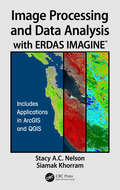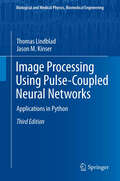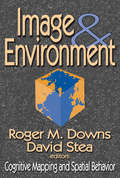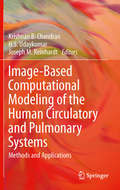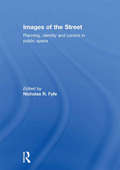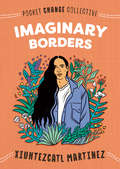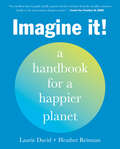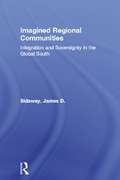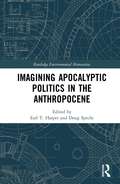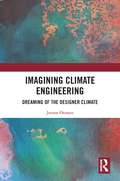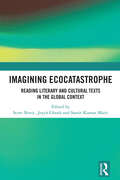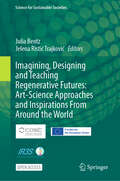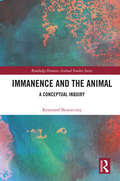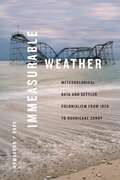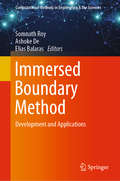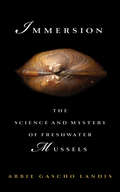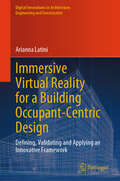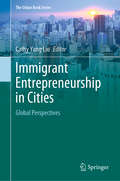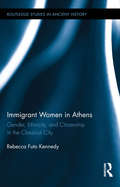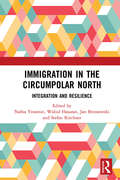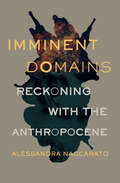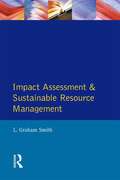- Table View
- List View
Image Processing and Data Analysis with ERDAS IMAGINE®
by Siamak Khorram Stacy A.C. NelsonRemotely sensed data, in the form of digital images captured from spaceborne and airborne platforms, provide a rich analytical and observational source of information about the current status, as well as changes occurring in, on, and around the Earth’s surface. The data products, or simply images processed from these platforms, provide an additional advantage in that geographic areas or regions of interest can be revisited on a regular cycle. This revisit cycle allows geospatial analysts and natural resource managers to explore changing conditions over time. Image Processing and Data Analysis with ERDAS IMAGINE® explains the principles behind the processing of remotely sensed data in a simple, easy to understand, and "how-to" format. Organized as a step-by-step guide with exercises adapted from original research and using publicly available imagery, such as NASA Landsat, ESA Sentinel-2, Orthophotos, and others, this book gives readers the ability to quickly gain the practical experience needed to navigate the ERDAS IMAGINE® software as well as learn certain applications in Esri’s ArcMap ArcGIS for Desktop software and Quantum the GIS (QGIS) open source applications package. It also helps readers to easily move beyond the information presented in this book and tackle more advanced skills. Written by two professors with long experience in remote sensing and image processing, this book is a useful guide and reference for both undergraduate and graduate students, researchers, instructors, managers, and agency professionals who are involved in the study of Earth systems and the environment.
Image Processing using Pulse-Coupled Neural Networks: Applications in Python
by Thomas Lindblad Jason M. KinserImage processing algorithms based on the mammalian visual cortex are powerful tools for extraction information and manipulating images. This book reviews the neural theory and translates them into digital models. Applications are given in areas of image recognition, foveation, image fusion and information extraction. The third edition reflects renewed international interest in pulse image processing with updated sections presenting several newly developed applications. This edition also introduces a suite of Python scripts that assist readers in replicating results presented in the text and to further develop their own applications.
Image and Environment: Cognitive Mapping and Spatial Behavior
by Roger M. Downs David SteaCognitive mapping is a construct that encompasses those processes that enable people to acquire, code, store, recall, and manipulate information about the nature of their spatial environment. It refers to the attributes and relative locations of people and objects in the environment, and is an essential component in the adaptive process of spatial decision-making--such as finding a safe and quick route to from work, locating potential sites for a new house or business, and deciding where to travel on a vacation trip.Cognitive processes are not constant, but undergo change with age or development and use or learning. Image and Environment, now in paperback, is a pioneer study. It brings a new academic discipline to a wide audience. The volume is divided into six sections, which represent a comprehensive breakdown of cognitive mapping studies: "Theory"; "Cognitive Representations"; "Spatial Preferences"; "The Development of Spatial Cognition"; "Geographical and Spatial Orientation"; and "Cognitive Distance." Contributors include Edward Tolman, James Blaut, Stephen Kaplan, Terence Lee, Donald Appleyard, Peter Orleans, Thomas Saarinen, Kevin Cox, Georgia Zannaras, Peter Gould, Roger Hart, Gary Moore, Donald Griffin, Kevin Lynch, Ulf Lundberg, Ronald Lowrey, and Ronald Briggs.
Image-Based Computational Modeling of the Human Circulatory and Pulmonary Systems
by Krishnan B. Chandran Joseph M. Reinhardt H. S. UdaykumarImage-Based Computational Modeling of the Human Circulatory and Pulmonary Systems provides an overview of the current modeling methods and applications enhancing interventional treatments and computer-aided surgery. A detailed description of the techniques behind image acquisition, processing and three-dimensional reconstruction are included. Techniques for the computational simulation of solid and fluid mechanics and structure interaction are also discussed, in addition to various cardiovascular and pulmonary applications. Engineers and researchers involved with image processing and computational modeling of human organ systems will find this a valuable reference.
Images of Delhi: A Literary and Humanistic Geography of Post-independence India
by Ramesh Chandra DhussaThe main objective of this book is to analyze prominent literary images of Delhi in post-independence India. The author has probed into a number of eminent writings in Hindi, English and other languages. The author's methodology, a humanistic and phenomenological approach, allows exploration of experiential dimension of writers’ and their characters in various genres of literature. An inquiry into perceptions and imagination in literature enriches the understanding of place, space, time, and seasons, the concerns central to geography. The Perceptions of the metropolis of Delhi interestingly vary between authors and their characters. The images of Delhi in plethora of literary works show a wide spectrum of colors. The images evoke feelings of reverence, love, adoration, dislike, indifference or neutrality. Experiences vary from places of beauty and grandeur to utterly ugly environments. Natives express different views and attitudes toward the city of Delhi from those of expatriate writers.
Images of the Street: Planning, Identity and Control in Public Space
by Nicholas R. FyfeImages of the Street captures the vitality, excitements and tensions of the street. Using examples from the U.K, India, Australia and North America the contributors draw on research in cultural geography, sociolgy, cultural studies and planning to explore the making and meaning of urban space.Among the themes examined are:1.the way streetscapes are shaped by interplay between politics, planning and local political economy 2.social differences of individuals experiences' of the street 3.how social identities are shaped and represented in fiction and film 4.the meaning and significance of streets as settings to play out social practices 5.how social life is regulated on the street, formerly by police and indirectly through architecture and urban design
Imaginary Borders (Pocket Change Collective)
by Xiuhtezcatl Martinez"It won't take you long to read this book, but it will linger in your heart and head for quite a while, and perhaps inspire you to join in the creative, blossoming movement to make this world work." -- Bill McKibben, environmentalist, New York Times bestselling author of The End of Nature, journalist, and founder of 350.org"An inspiring story that will change the way all of us think about the climate crisis - and how we can solve it." -- Van Jones, New York Times bestselling author of The Green Collar Economy and Rebuild the Dream, and co-founder of Dream Corps"A hopeful, well-argued book on climate change written in a refreshing new voice."-- Kirkus Reviews, starred review"Martinez presents a meaningful, heartfelt call to action with content that reflects current issues. Additionally, the book's short length will appeal to reluctant readers. An essential purchase for any high school or public library."-- School Library Journal, starred reviewIn this personal, moving essay, environmental activist and hip-hop artist Xiuhtezcatl Martinez uses his art and his activism to show that climate change is a human issue that can't be ignored.Pocket Change Collective is a series of small books with big ideas from today's leading activists and artists. In this installment, Earth Guardians Youth Director and hip-hop artist Xiuhtezcatl Martinez shows us how his music feeds his environmental activism and vice versa. Martinez visualizes a future that allows us to direct our anger, fear, and passion toward creating change. Because, at the end of the day, we all have a part to play.
Imagination and Environmental Political Thought: The Aftermath of Thoreau (Politics, Literature, and Film)
by Joshua J. Bowman<p>Imagination and Environmental Political Thought: The Aftermath of Thoreau seeks to correct oversimplified readings of Henry David Thoreau’s political thought by elucidating a key tension within his imagination. With the celebration of Thoreau’s two-hundredth birthday now past, this study outlines, and builds on, his own understanding of imagination and considers its implications for environmental politics. Despite the use of the word, “aftermath,” Thoreau’s legacy for environmental political thought is primarily constructive and foundational for modern environmentalism. <p>Thoreau’s virtues and vices have been inherited by his environmentally-conscious readers. The author of Walden’s preference for an abstract, ahistorical “higher law,” his radical concept of autonomy, and his frustration with government and community foster an impractical political thought characteristic of an idyllic imagination. Nevertheless, Thoreau demonstrates a more prudential and moral imagination by emphasizing the inescapable relationship between the moral order of individuals and the order of political communities and by pioneering the central questions of humanity’s relationship to non-human nature. Can this tension of imaginations be resolved? What are the consequences of this tension? <p>Thoreau’s overall vision ultimately creates significant problems with which environmentalists still struggle. While Thoreau’s emphasis on freedom and the immaterial aspects of human and non-human nature are of considerable value, his abstract political morality, misanthropy and escapism must be resisted both for the sake of environmental well-being and human dignity. <p>In addition, this book is an exercise in re-thinking how the humanities may provide scholars critical insights to better diagnose and respond to the environmental challenges of our time.</p>
Imagine It!: A Handbook for a Happier Planet
by Laurie David Heather ReismanAn inspirational, accessible, and actionable guide for empowering and inspiring you to take concrete steps towards living more sustainably. &“An excellent how-to guide [and] a great read for everyone from the socially conscious family to the most ardent climate activist.&”—Former Vice President Al GoreImagine It! is a handbook for those who want to begin or advance a journey toward living in better balance with our planet. It inspires, supports, and offers easy ways to replace old, planet-hurting habits with new healthy ones. In Imagine It!, the documentary filmmakers behind Writing on the Wall, Fed Up, The Biggest Little Farm, The Social Dilemma, and the Academy Award–winning An Inconvenient Truth highlight the need to change some of our food, clothing, and transportation habits and meaningfully lower our use of plastic, paper, water, and harmful chemicals. They call the changes in these areas lifestyle shifts, and there is a chapter devoted to each one of them in the book. Each begins with a short story on the shift being explored, and then provides clear steps for replacing old habits with new ones to create lasting change. Laurie David and Heather Reisman are no strangers to exposing hard truths and helping audiences understand their part in bringing about change. They know a cleaner, healthier world is ours for the taking—and to start, we just have to Imagine It!
Imagined Regional Communities: Integration and Sovereignty in the Global South (Routledge Studies in Human Geography #Vol. 5)
by James D. SidawayImagined Regional Communities provides an original approach to thinking about the processes of regional integration. Focusing mostly on communities in Africa, Asia and Latin America, it develops detailed case studies based on archives, interviews and critical readings of existing texts. These case-studies are related to each other and the overall themes of the book, so that a set of narratives and theoretical elaborations emerge, that critically reformulate understandings of regional communities, statehold and sovereignty.
Imagining Apocalyptic Politics in the Anthropocene (Routledge Environmental Humanities)
by Earl T. HarperBringing together scholars from English literature, geography, politics, the arts, environmental humanities and sociology, Imagining Apocalyptic Politics in the Anthropocene contributes to the emerging debate between bodies of thought first incepted by scholars such as Mouffe, Whyte, Kaplan, Hunt, Swyngedouw and Malm about how apocalyptic events, narratives and imaginaries interact with societal and individual agency historically and in the current political moment. Exploring their own empirical and philosophical contexts, the authors examine the forms of political acting found in apocalyptic imaginaries and reflect on what this means for contemporary society. By framing their arguments around either pre-apocalyptic, peri-apocalyptic or post-apocalyptic narratives and events, a timeline emerges throughout the volume which shows the different opportunities for political agency the anthropocenic subject can enact at the various stages of apocalyptic moments. Featuring a number of creative interventions exclusively produced for the work from artists and fiction writers who engage with the themes of apocalypse, decline, catastrophe and disaster, this innovative book will be of great interest to students and scholars of the politics of climate change, the environmental humanities, literary criticism and eco-criticism.
Imagining Climate Engineering: Dreaming of the Designer Climate
by Jeroen OomenThis book highlights the increasing attention for climate engineering, a set of speculative technologies aimed to counter global warming. What is the future of the global climate? And who gets to decide—or even design—this future? Imagining Climate Engineering explores how and why climate engineering became a potential approach to anthropogenic climate change. Specifically, it showcases how views on the future of climate change and climate engineering evolved by addressing the ways in which climate engineers view its respective physical, political, and moral domains. Tracing the intellectual and political history of dreams to control the weather and climate as well as the discovery of climate change, Jeroen Oomen examines the imaginative parameters within which contemporary climate engineering research takes place. Introducing the analytical metaphor ‘ways of seeing’ to describe explicit or implicit visions, understandings, and foci that facilitate a particular understanding of what is at stake, Imagining Climate Engineering shows how visions on the knowability of climate tie into moral and political convictions about the possibility and desirability of engineering the climate. Marrying science and technology studies and the environmental humanities, Oomen provides crucial insights for the future of the climate change debate for scholars and students.
Imagining Ecocatastrophe: Reading Literary and Cultural Texts in the Global Context
by Scott Slovic Joyjit Ghosh Samit Kumar MaitiThis volume examines scholarly perspectives on eco-imaginaries, focusing in particular on how eco-catastrophes have been represented in literature and different visual forms, including film, television and cartoons, among other cultural media. It draws on literary genres such as science fiction, climate fiction, speculative fiction, petrofiction, post-apocalyptic narratives and nuclear fiction to examine the role that literature plays in the dissemination of information about environmental crisis in the Anthropocene and in preparing mankind for a better and sustainable future. Deeply embedded in theoretical conceptualisations, the essays in this volume address issues of natural disasters, deforestation, nuclear disasters and pandemics, among others, which constitute the core subjects of environmental humanities. A seminal study on the literary and cultural representations of ecodisaster in the global context, and with contributions from across the world, this book, truly interdisciplinary in nature, will be an invaluable read for students, academicians and researchers in literature, film studies, climate change studies, disaster studies, gender studies and cultural studies.
Imagining Sustainability: Creative urban environmental governance in Chicago and Melbourne (Routledge Research in Sustainable Urbanism)
by Julie CidellCities, rather than nations, have become the key sites for enacting environmental policies. This is due to the combination of growing urban populations and increased action on the part of local governments (generally attributed to national governments’ failure to act on climate change). Imagining Sustainability seeks to understand how actors in local government conceptualize sustainability and their role in producing it, and what difference that understanding makes to their physical, political, and social environments now and in the future. International comparisons can uncover new ideas and possibilities. Chicago and Melbourne are prime candidates for such a comparison: they are cities of the same age, they have similar historical trajectories as interior gateways followed by industrial growth and then deindustrialization, and they have demonstrated the same recent desire to be global champions of sustainability. Based on qualitative fieldwork in these two cities, this book uses Karen Barad’s methodology of diffraction to read these case studies through each other. This methodology helps to understand not only what differences exist between these two places, but what effects those differences have on the urban environment. This book will be of great interest to students and scholars of urban studies, urban planning and environmental policy and governance.
Imagining, Designing and Teaching Regenerative Futures: Art-Science Approaches and Inspirations From Around the World (Science for Sustainable Societies)
by Julia Bentz Jelena Ristić TrajkovićThis open access book explores the potential of transdisciplinary, art-science approaches in addressing current social-ecological complexities within educational contexts. Moving beyond disciplinary perspectives this book integrates holistic, transdisciplinary approaches and creates spaces for imagining and co-creating just, liveable, healthy futures. As we face the urgent need for new ways of learning and engaging with nature, this volume emphasizes the importance of humans as integral parts of living systems. By fostering a regenerative and holistic perspective while improving wellbeing for humans and non-humans, the book offers tools and methods that invite learners to reimagine their relationships with nature and with the future. It includes innovative approaches for community engagement, design, future visioning, experiential, embodied, and playful learning, providing a comprehensive resource for educators, community workers, policy makers, designers, scientists, architects, and urban planners. The book brings together creative, art-science approaches to advance transformative education in the field of sustainability science. Structured as a practical manual, it offers innovative methodologies with clear instructions for application in various learning environments. Offering tutorials for 65 creative methods developed by the 120 authors from all around the world, this book offers a transdisciplinary and transcontextual approach making it relevant to a wide audience. This collaborative project is an output of the Cost Action CA21166 - Social Sciences and Humanities for Transformation and Climate Resilience (SHiFT) that brings together researchers and practitioners from different disciplines to address sustainability transformation.
Immanence and the Animal: A Conceptual Inquiry (Routledge Human-Animal Studies Series)
by Krzysztof SkoniecznyThis book reexamines the concept of the animal on the plane of immanence, as opposed to the traditional viewpoint founded on the plane of transcendence. Following Deleuze and Guattari’s notion that philosophy is a discipline of creating concepts, this book traces how the concept of the animal was created in the history of philosophy through re-reading the works of Descartes, Kant, Heidegger, Derrida and Levinas. Their theories show that the concept of the animal was constructed on the "plane of transcendence" as subservient to the self-serving human, who represents the animal as a negative entity devoid of reason, ethics, the ability to enter into political alliances or even die. With this perspective and a range of theories from thinkers such as Spinoza, Nancy, Haraway and Braidotti as the groundwork, a new positive concept of the animal, operating on the plane of immanence, is sketched out, compelling a reappraisal of the relationships between body and thought, ethics and politics, or life and death. With comprehensive interpretations of the views of several key philosophers, from Kant and Heidegger to Deleuze, Derrida and Agamben, this book will be valuable for scholars of theoretical animal studies and continental philosophy interested in the philosophical significance of the animal question.
Immeasurable Weather: Meteorological Data and Settler Colonialism from 1820 to Hurricane Sandy (Elements)
by Sara J. GrossmanIn Immeasurable Weather Sara J. Grossman explores how environmental data collection has been central to the larger project of settler colonialism in the United States. She draws on an extensive archive of historical and meteorological data spanning two centuries to show how American scientific institutions used information about the weather to establish and reinforce the foundations of a white patriarchal settler society. Grossman outlines the relationship between climate data and state power in key moments in the history of American weather science, from the nineteenth-century public data-gathering practices of settler farmers and teachers and the automation of weather data during the Dust Bowl to the role of meteorological satellites in data science’s integration into the militarized state. Throughout, Grossman shows that weather science reproduced the natural world as something to be measured, owned, and exploited. This data gathering, she contends, gave coherence to a national weather project and to a notion of the nation itself, demonstrating that weather science’s impact cannot be reduced to a set of quantifiable phenomena.
Immersed Boundary Method: Development and Applications (Computational Methods in Engineering & the Sciences)
by Ashoke De Somnath Roy Elias BalarasThis volume presents the emerging applications of immersed boundary (IB) methods in computational mechanics and complex CFD calculations. It discusses formulations of different IB implementations and also demonstrates applications of these methods in a wide range of problems. It will be of special value to researchers and engineers as well as graduate students working on immersed boundary methods, specifically on recent developments and applications. The book can also be used as a supplementary textbook in advanced courses in computational fluid dynamics.
Immersion: The Science and Mystery of Freshwater Mussels
by Abbie Gascho LandisAbbie Gascho Landis first fell for freshwater mussels while submerged in an Alabama creek, her pregnant belly squeezed into a wetsuit. After an hour of fruitless scanning, a mussel materialized from the rocks—a little spectaclecase, herself pregnant, filtering the river water through a delicate body while her gills bulged with offspring. In that moment of connection, Landis became a mussel groupie, obsessed with learning more about the creatures' hidden lives. She isn't the only fanatic; the shy mollusks, so vital to the health of rivers around the world, have a way of inspiring unusual devotion.In Immersion: The Science and Mystery of Freshwater Mussels, Landis brings readers to a hotbed of mussel diversity, the American Southeast, to seek mussels where they eat, procreate, and, too often, perish. Accompanied often by her husband, a mussel scientist, and her young children, she learned to see mussels on the creekbed, to tell a spectaclecase from a pigtoe, and to worry what vanishing mussels—70 percent of North American species are imperiled—will mean for humans and wildlife alike. In Immersion, Landis shares this journey, traveling from perilous river surveys to dry streambeds and into laboratories where endangered mussels are raised one precious life at a time.Mussels have much to teach us about the health of our watersheds if we step into the creek and take a closer look at their lives. In the tradition of writers like Terry Tempest Williams and Sy Montgomery, Landis gracefully chronicles these untold stories with a veterinarian's careful eye and the curiosity of a naturalist. In turns joyful and sobering, Immersion is an invitation to see rivers from a mussel's perspective, a celebration of the wild lives visible to those who learn to search.
Immersive Virtual Reality for a Building Occupant-Centric Design: Defining, Validating and Applying an Innovative Framework (Digital Innovations in Architecture, Engineering and Construction)
by Arianna LatiniThis book discusses the cutting-edge intersection of Immersive Virtual Reality (IVR) and research on building occupants. It presents an innovative way of using IVR to revolutionise the comprehension of human-dimension responses to indoor built environments. A robust, innovative, and sequential protocol is defined and validated with a Virtual Environment against a real-world counterpart to provide readers with methodological approaches suitable for carrying out rigorous experimental research in building occupant research. This comprehensive guide provides also practical applications of the proposed guidelines to show the potential and effectiveness of IVR for conducting studies in different indoor environmental conditions in a multi-sensory approach. The book serves as a resource for researchers who want to exploit the full potential of VR in collecting reliable data useful for understanding human dimensions within built environments.
Immigrant Entrepreneurship in Cities: Global Perspectives (The Urban Book Series)
by Cathy Yang LiuThis book draws on evidence from global cities around the world and explores various dimensions of immigrant entrepreneurship and urban development. It provides a substantive contribution to the existing literature in several ways. First of all, it pursues a comparative approach, with case studies from both the global north and global south, so as to broaden the theoretical framework in this area especially as pertinent to emerging economies. Second, it covers multiple scales, from local community place-making, to urban contexts of reception, to transnational networks and connections. Third, it combines approaches and research methods from numerous disciplines, investigating entry dynamics, trends and patterns, business performance, challenges, and the impact of immigrant entrepreneurship in urban areas. Finally, it pays particular attention to current international experiences regarding urban policies on immigrant entrepreneurship. Given its scope, the book will be an enlightening read for anyone interested in immigration, entrepreneurship and urban development issues around the globe.As global cities around the world continue to attract both domestic migrants and international migrants to their bustling metropolises, immigrant entrepreneurship is emerging as an important urban phenomenon that calls for careful examination. From Chinatown in New York, to Silicon Valley in San Francisco, to Little Africa in Guangzhou, immigrant-owned businesses are not only changing the business landscape in their host communities, but also transforming the spatial, economic, social, and cultural dynamics of cities and regions.
Immigrant Women in Athens: Gender, Ethnicity, and Citizenship in the Classical City (Routledge Studies in Ancient History)
by Rebecca Futo KennedyMany of the women whose names are known to history from Classical Athens were metics or immigrants, linked in the literature with assumptions of being ‘sexually exploitable.’ Despite recent scholarship on women in Athens beyond notions of the ‘citizen wife’ and the ‘common prostitute,’ the scholarship on women, both citizen and foreign, is focused almost exclusively on women in the reproductive and sexual economy of the city. This book examines the position of metic women in Classical Athens, to understand the social and economic role of metic women in the city, beyond the sexual labor market. This book contributes to two important aspects of the history of life in 5th century Athens: it explores our knowledge of metics, a little-researched group, and contributes to the study if women in antiquity, which has traditionally divided women socially between citizen-wives and everyone else. This tradition has wrongly situated metic women, because they could not legally be wives, as some variety of whores. Author Rebecca Kennedy critiques the traditional approach to the study of women through an examination of primary literature on non-citizen women in the Classical period. She then constructs new approaches to the study of metic women in Classical Athens that fit the evidence and open up further paths for exploration. This leading-edge volume advances the study of women beyond their sexual status and breaks down the ideological constraints that both Victorians and feminist scholars reacting to them have historically relied upon throughout the study of women in antiquity.
Immigration in the Circumpolar North: Integration and Resilience
by Nafisa YeasminImmigration in the Circumpolar North: Integration and Resilience explores interconnected issues of integration and resilience among both immigrants and host communities in the Arctic region. It examines the factors that inhibit or enable the success of immigrants to the Arctic and the role of territoriality in the process of integration This book showcases a variety of perspectives on circumpolar immigration, and includes insights from eight Arctic countries as well as thirteen ‘observer countries’ such as China, India, Singapore, Poland, Germany, France and Japan. It considers the solidarities and engagements of indigenous and other local peoples with the new coming immigrants and refugees, and the impact of immigration on the economic and societal life in the Circumpolar Arctic. The book will be of interest to researchers, teachers, professors, policymakers and others interested in migration issues, Arctic issues, international relations, law, and economic integration.
Imminent Domains: Reckoning with the Anthropocene
by Alessandra NaccaratoImminent Domains: Reckoning with the Anthropocene invites readers to join a contemplation of survival—our own, and that of the elements that surround us. Using research, lyric prose, and first-hand experiences, Alessandra Naccarato addresses fundamental questions about our modern relationship to nature amidst depictions of landscapes undergoing dramatic transformation.We trace the veins of harm, memory and meaning amongst ecosystems and bioregions; through history and across continents, from the mines of Cerro Rico to the ruins of Pompeii. Arranged by five central elements of survival—earth, fire, water, air and spirit—these essays refute linearity, just as nature does.Naccarato offers not blanket answers about our future, but rather myriad ways to find our own, individual response to an imminent question. We are being called to work together; to dig a trench deep and wide enough that the fires around us might stay at bay. How do we turn towards the fire?
Impact Assessment and Sustainable Resource Management (Themes In Resource Management)
by L Graham SmithFirmly places impact assessment in the broader context of environmental planning, developing a much-needed integrative approach. The topics covered include: decision making and dispute resolution; the role of environmental law; public policy, administration and publication participation; the nature of planning; impact assessment methodology; the application of impact assessment to frontier developments; linear facilities and waste mana
